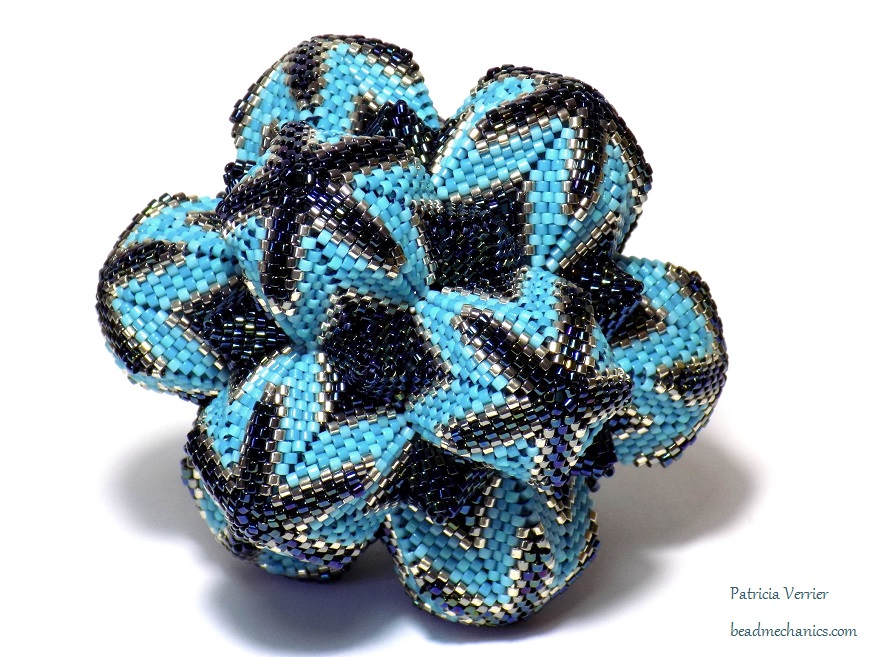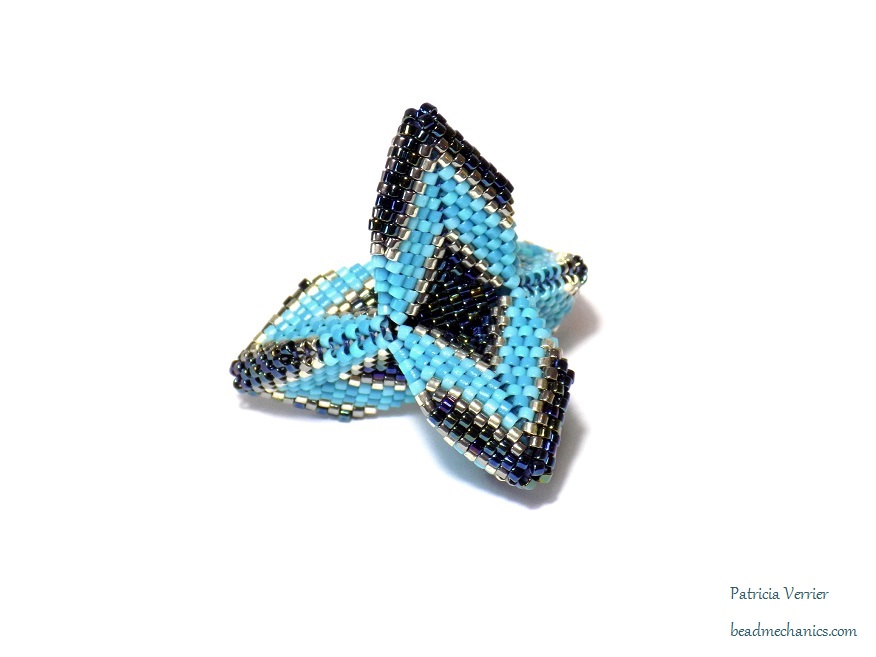While I was making the first rick-rack dodecahedron I had an idea for a slight variation made by joining the rick racks together point-to-point instead of edge to edge. Since this would require a join between three edges, I first thought that I could use a warped hexagon instead of a warped square. However, I was completely wrong about that! The angle of the warped hexagon was far too small. After a bit of trial and error I found that three warped squares joined into a pyramid on two of their sides resulted in a triangular shape with the right surface angle. I then spent the better part of a day trying out different colour combinations and patterns to end up at the conclusion that they looked best just all in the dark blue colour. It’s a bit of extra work making the three squares for each join but they look great – the small pyramids create this extra spikey structure around the rick racks that I really like. Here’s the finished piece:

If you compare it to the original you can see the differences – in the new shape two rick-rack points meet at each join where in the original three points meet at each join:

You can see the difference in how the two are constructed in the diagram below – on the left is the variation and on the right is the original:
The two polyhedra – the original and the variation – correspond to a dodecadodecahedron (no that’s not a typo!) and a ditrigonal dodecadodecahedron. (Although the triangular faces on the new shape are convex not concave, but close enough!). The original shape is also similar to a hyperbolic dodecahedron (which I believe is a dodecahedron that tessellates in hyperbolic space, rather than is entirely hyperbolic itself).
I was also asked if it was possible to make smaller shapes such as tetrahedra or cubes out of rick-racks and warped squares. The crucial factor here is the angle of the warped squares – their maximum angle (the angle between the ‘V’ shape each one forms) is about the same as the angle needed to join the rick-racks together on a dodecahedron. They’ll squash down enough to join together rick-racks at a smaller angle, which should make shapes with higher dihedral angles (i.e. less pointy edges) possible, such as truncated icosahedra, but not those with small dihedral angles such as tetrahedra. Fortunately there’s an easy solution! You can make something something very similar to a warped square by joining two triangles together one on side, as shown on the below on the left, compared to the original warped square join on the right:
Unlike the square however, the triangles will bend to any angle along this join, which should make any regular or semi-regular polyhedra possible! To test the idea I made a tetrahedron using this method:

The rick-racks here have three peaks instead of five, but otherwise it’s made in exactly the same way as the original dodecahedron, just joining each one together with the pairs of triangles instead of with a warped square. The resultant shape is very pointy (and hard to photograph!) but much quicker to make!
I’ve now made a set of podcasts with various different numbers of sides so I can make a whole set of these polyhedra!





Hi,
I bought your pattern to make the original “polyhedra.” Is there now a second version??
I a planning to make this as soon as i finished a current project involving 80 triangles!
Suzanne
>
LikeLike
Hi Suzanne,
This is a variation on my recent rick-rack shape – brief instructions for which are available here on my blog: https://beadmechanics.com/2018/08/12/rick-rack-dodecahedron-with-tutorial/. It’s made a bit differently to my other patterns, and uses the recent CGB podcast technique to create the small rick-racks!
80 triangles sounds like a lot of triangles!! But it also sounds intriguing!
Patricia
LikeLike
My mathematical and 3D abilities are very limited. I’m working on a construction with triangles and have been racking my head and experimenting for weeks, so I laughed out loud when a read that you’d spent a day figuring it out. Another fabulous piece.
LikeLike
I often make huge mistakes with what I think will work compared to what will actually work! I’m not very good at visualizing things without the shape in front of me, which can make working on polyhedra a bit difficult sometimes! (Although strangely can make other bits of maths much easier…) I tend to rely on the basics of how many shapes of what type and at what angle I need to join to make a basic shape and work go from there. Although this often goes wrong when I add up the angles incorrectly too! The upside is that the finished object is always a surprise when I complete it!
LikeLike
This is absolutely awesome! Love this, and shall attempt my own. Thank you for sharing!
Best regards
Susie
Cape Town
LikeLiked by 1 person
Tanks Susie! Will you share a photo when it’s done? It’s great seeing the different versions of it!
LikeLike
“After a bit of trial and error I found that three warped [squares] joined into a pyramid on two of their sides resulted in a triangular shape with the right surface angle.”
You may want to make the above edit replacing “hexagons” as originally written with squares. Two sentences later you correctly explain, “It’s a bit of extra work making the three squares for each join…”
Thank you so much for the excellent descriptions and the inspirational beadwork.
LikeLike
Whoops, well spotted! Now corrected, thanks.
LikeLike